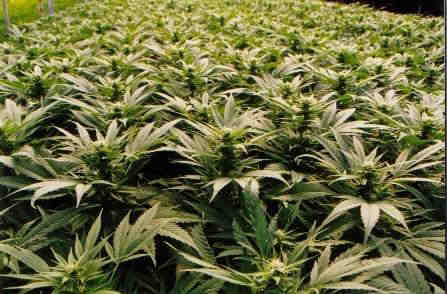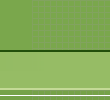|
Growing
cannabis Sea of green Method
Sea of Green (SOG)
is the theory of harvesting lots of small plants, matured early
to get the fastest production of buds available. Instead of
growing a few plants for a longer period of time, in the same
space many smaller plants are grown that mature faster and in
less time. Thus, less time is required between crops. This is
important to you when the electricity bill comes each month. One
crop can be started while another is maturing, and a continuous
harvest, year round can be maintained. 4 plants per square foot
will be a good start for seedlings. 1 plant per square foot will
allow plenty of room for each plant to grow a large top cola,
but will not allow for much bottom branching. This is OK since
indoors, these bottom branches are always shaded anyway, and
will not grow very well unless given additional light and space.
The indoor grower quickly realizes that plants that are too tall
do not produce enough at the bottom to make the extra growing
time used worth while. An exception to this rule would be if it
is intended the plants are to go outside at some point, and it
is expected that the light/shading issue will not be a factor at
that point.

The plants, if
started at the same time, should create what is called a "green
canopy" that traps most of the light at the top level of the
plants. Little light will penetrate below this level, since the
plants are so close together. The gardener is attempting to
concentrate on the top of the plant, and use the light and space
to the best advantage, in as little time as possible. Use of
nylon poultry fence or similar trellising laid out over the
green canopy will support the plants as they start to droop
under the weight of heavy fruiting tops. Stakes can be used too,
but are not as easy to install for plants in the middle and back
of the room, where reach is more difficult.
It is easy to want
big plants, since they will produce more yield per plant, but it
is usually better with limited space to grow smaller plants that
mature faster and pack into smaller spaces. Sea of Green was
developed in Holland. Instead of fitting 4 large plants in that
small room, fit 12 small ones on a shelf above 12 other small
plants. These plants take only 3-4 months to mature from
germination to ripe buds, and harvesting takes place constantly,
since there is both a vegetative and flowering area devoted to
each, with harvests every 45-60 days.
It is not the size
of the plant, but the maturity and quality of the product that
counts. Twice as many plants grown half as big will fill the
grow space twice as fast, so harvests take place almost twice as
often. Get good at picking early flowering plants, and propagate
only those that are of the best quality.
6" square
containers will allow for 4 plants per square foot. You may also
gauge by the size of your growing tray (for passive
hydroponics); I like kitty litter boxes. ($3 each at Target)
Planted 4 per square foot, (for vegatative seedlings) a 12 sq.
ft. closet will hold 48 seedlings on one shelf. In my case, I
use 4" rockwool cubes that fit into kitty litter pans @ 12 cubes
per pan. I can get 5 pans onto a 12 sq. ft. closet upper shelf,
so that is 60 seedlings on one small shelf!
For flowering
indoors, 1 plant per sq. ft. is a good rule of thumb for SOG. If
less plants are grown in this size space, it will take them
longer to fill the space, thus more electricity and time will be
used to create the same amount of product. If more than one
plant p.s.f. is attempted, the grower will soon find that plants
thus crowded tend to be more stem than bud, and the total
harvest may be reduced, so be cautious.
It is good to
avoid "topping" your plants if you want them to grow as fast as
possible. It is better just to grow 2 or 4 times more plants,
since they will produce more, faster, in the same space. Also,
"training" plants with twist-ties is a great way to get them to
bush out a bit. Just take any type of plastic or paper twist tie
and wrap it around the top of the plant, then pull it over until
the top is bent over 90-180 degrees and then attach this to the
main stem lower on the plant. Do this for one week and then
release the plant from it is bond. The plant can be trained in
this fashion to take less vertical space and to grow bushier, to
fill the grow space and force lower limbs to grow upward and
join the green canopy. This technique takes advantage of the
fact that if the top is pulled over, it creates a hormonal
condition in the plant that makes it bush out at all lower
internodes.
Sea of Green
entails growing to harvest the main cola (top) of the plant.
Bottom branches are trimmed to increase air flow under the
"blanket" of growing tops. Use these cuttings for clones, as
they are the easiest part of the plant to root. It is also the
fastest part of the plant to regenerate after flowering has
occurred.
|









